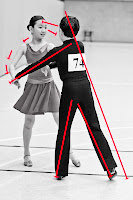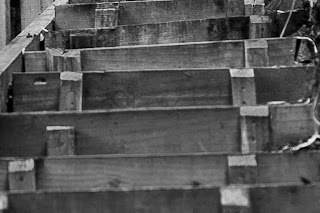Exercise: Horizontal and Vertical Lines.
Lines have a stronger graphic qualities than points.
Here we were asked to look for specific examples of horizontal and vertical lines. Looking back through my images, I noticed I have many verticals and diagonals, but not too many isolated examples of horizontals. Here I have tried to isolate the horizontal, i.e., subordinate the content of the image to the line.
1. Here you can see the horizontal line of the grass, and then the top of the sign (the vertical line of the post, actually makes this image a more dynamic).
2. I went for a walk and saw this sign and immediately thought of the horizontal lines of the frame. The actual top and bottom of the frame form horizontals along with the actual lines on the sign.
3. Here you can see the horizontal line at the edge of the sand, then in the background there is the horizon which forms the second horizontal line. I chose this image because I wanted to highlight the number of horizontals which surround us in everyday. As Freeman states [1] horizontals are more static than verticals and because our own frame of vision is horizontal, the horizontal lines are visually more comfortable.
4. The rough wooden steps make interesting horizontals.
I particularly liked the horizontal grain on the wooden board walk shown in this photograph. Just goes to show you that lines are absolutely everywhere.
Verticals
1. Vertical lines, on a shipping container (which had been made into portable toilets). I was drawn to initially to the uniform shape of the container, then to the vertical lines on the container itself.
2. vertical lines are visible on the sides of this 3-D poster board. This was a very bright image, but in black and white, it serves to highlight the vertical lines on the sides of the display. The fixture contrasts nicely with the background.
3. vertical lines in the form of pipes on the outside of this gas tower. I like the contrast of vertical and circular here. The image is dynamic the circles pull the eye one way and the vertical direct attention another, upwards.
4. the railings are vertical lines - I found a small grave yard, and this fence caught my eye. Initially, I was caught by the contrast of the rusty railings and the growth of the grass on the grave. I have closely cropped the photo to give greater effect to the vertical lines.
In conclusion:
Horizontal and Vertical lines have a much stronger graphic impact than points they: (i) divide the frame and (ii) direct the viewers gaze around the frame whilst having a more dynamic quality. As Freeman states at page 77 of the course materials, the frame of a photograph has vertical and horizontal sides, the eye uses these as references and it is easy to detect any tilt in the lines of the picture. Horizontal lines are more static and comfortable, they "express stability, weight and calm" [2] and do not require as much explanation as vertical lines. Vertical lines have a stronger sense of movement, they add drama to an image and somehow have stronger vectors carrying the eye in a dynamic movement.
I actually re-read some of the early chapters in The Photographer's Eye[3] - and it was easier this time round to digest some of the information on placement, dividing the frame and horizon. I think the exercise on points has helped to absorb the concept of movement, division and placement. Sitting on top of this, is the principle of dividing the frame and the various principles which advocate the various proportions or rules, on which the frame is divided. I think the exercises on graphic elements are helpful in understanding the basic principles we looked at in Part One. It is always worthwhile revisiting the basic elements, each time I hope to glean something new from this practise.
[1] Freeman, Michael,(2007). The Photographer's Eye: Composition and Design for Better Digital Photos, The Ilex Press, p,72
[2] Freeman, Michael,(2007). The Photographer's Eye: Composition and Design for Better Digital Photos, The Ilex Press, p,72
[3]Freeman, Michael,(2007). The Photographer's Eye: Composition and Design for Better Digital Photos, The Ilex Press
Other examples - although the concrete blocks form a repeated pattern, they also resemble vertical lines.
Here the vertical line of the edge of the wall, dissects the image and directs the gaze along its length. Interestingly, the shadows in the background, are both vertical and diagonal.













































.jpg)





.jpg)



